Performance Meter
0%
QUESTION ID:1
A chemist synthesizes three new chemical compounds in the laboratory and names them as X, Y and Z. After analysing mutagenic potential of all these compounds, the geneticist observed that all are highly mutagenic. The geneticist also tested the potential of mutations induced by these compounds to be reversed by other known mutagens and obtained the following results
Assuming that X, Y and Z caused any of the three types of mutations, transition, transversion or single base deletion, what conclusions can you make about the nature of mutations produced by these compounds?

QUESTION ID:2
An individual is having an inversion in heterozygous condition. The regions on normal chromosome are marked as A, B, C, D, E, F, G while the chromosome having inversion has the regions as a, b, e, d, c, f, g. The diagram given below shows pairing of these two homologous chromosomes during meiosis and the site of a crossing over is indicated:
The following statements are given to describe the inversion and the consequence of crossing over shown in the above diagram:
A. This is a pericentric inversion
B. This will generate a dicentric and an acentric chromosome following separation of chromosomes after crossing over
C. This will generate two monocentric recombinant chromosomes following separation of chromosomes after crossing over
D. All the gametes thus formed will have deletion and/or duplication and will be non-viable
E. 50% of the gametes having recombinant chromatid will be non-viable, while 50% gametes having non-recombinant chromatid will survive
F. This is a paracentric inversion
Which combination of the above statements describe the inversion and meiotic consequences correctly
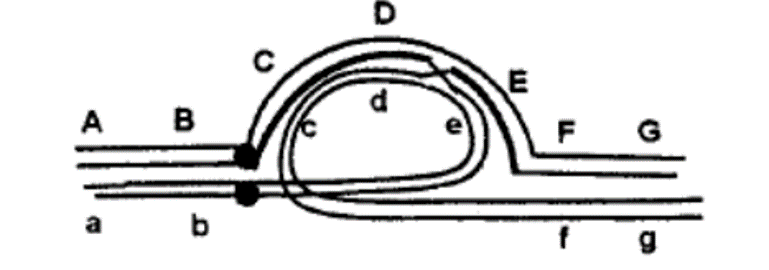
QUESTION ID:3
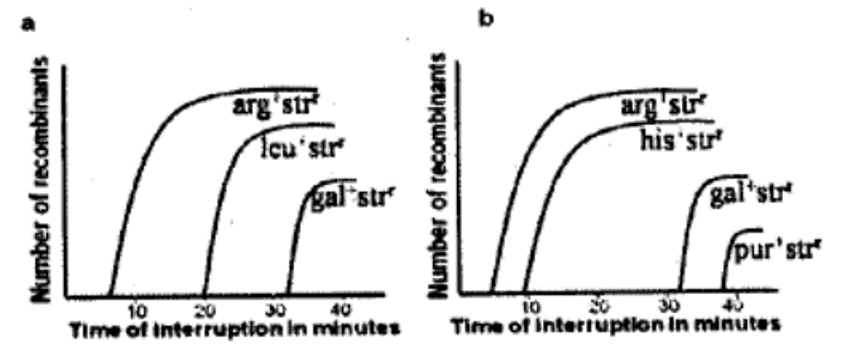




QUESTION ID:4
Three anatomical characteristics (A, B and C) of invertebrate nervous system are used to build a generalized cladogram given below. Presence of the anatomical character is indicated by '+'
Based on the pattern of character distribution, pick the correct combination that are represented by A, B and C
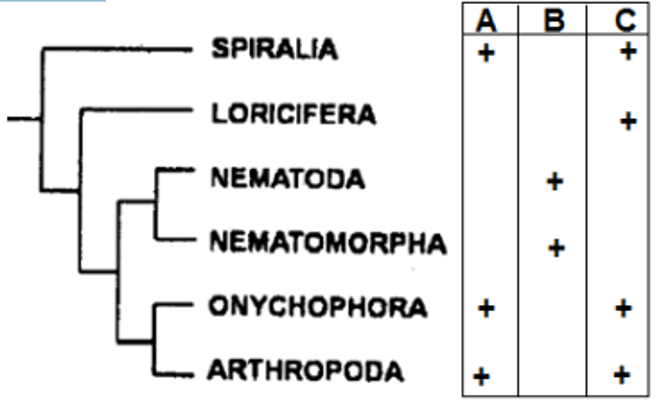
QUESTION ID:5
In order to survive in a non-aquatic environment, plants acquired several adaptations with specialized functions. Given below is a list of features/characteristics (Column A) and their potential role (Column B).
Which one of the following options represents a correct match between the adaptations and their functions?

QUESTION ID:6
Following table presents bryophyte phyla with their selected characteristics: In the above table, phyla A, B and C represent
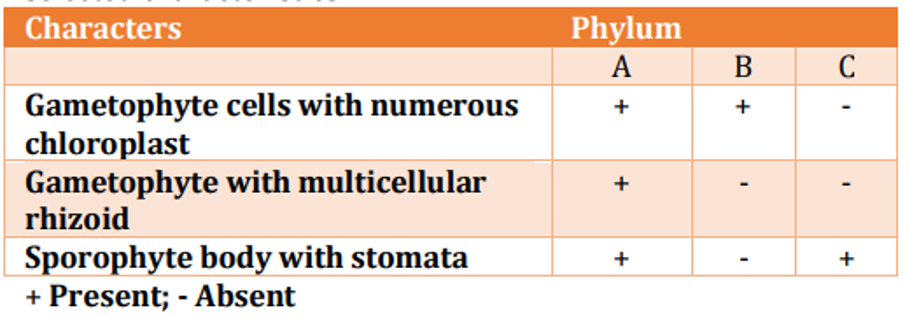
QUESTION ID:7
Following table shows a list of clades and plants: Which one of the following is a correct match for the above?

QUESTION ID:8
The following table shows names of bones (Column A) and specific features (Column B). Which one of the following options gives the correct match of the bones with their specific features?

QUESTION ID:9
The figure below shows the nervous system of Mollusca with ganglia and the connecting nerves. The connecting nerves are labelled as A, B, C and D. Which one of the following options has correct labelling of A, B, C and D?
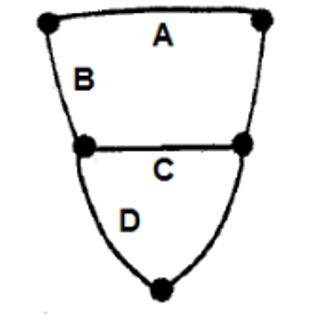
QUESTION ID:10
Following are certain statements regarding energy efficiencies of ectotherms and endotherms:
A. Ectotherms have high assimilation efficiency but low production efficiency.
B. Ectotherms have low assimilation efficiency but high production efficiency.
C. Endotherms have high assimilation efficiency but low production efficiency.
D. Endotherms have low assimilation efficiency but high production efficiency.
Which one of the following represents the combination of correct statements?
QUESTION ID:11
Given below are some properties related to botanical and zoological nomenclature.
A. Absence of tautonyms
B. Presence of genus and species ranks only
C. Absence of principle of coordination
D. Presence of only holotype and neotype
Select the correct combination that distinguishes botanical nomenclature from zoological nomenclature system.
QUESTION ID:12
Following table gives a list of international environmental agreements and areas covered. Which of the following is correct combination?
QUESTION ID:13
The following figure is a "risk-graph" that illustrates the percent risk a species faces towards extinction The following are ranks assigned according to IUCN's red-list category:
(i) Critically endangered
(ii) Near threatened
(iii) Vulnerable
(iv) Least concern
Which one of the following is the most appropriate match between the percent-risk and their assigned rank?
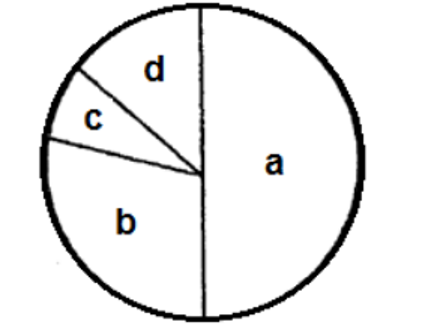
QUESTION ID:14
The complexity of a food web in a community is quantified using certain parameters which are defined below. Which of the following is an INCORRECT representation?




QUESTION ID:15
The above graph illustrates two lines that represent the immigration and extinction rates for an island based on its distance from mainland (solid line) and its size (dotted line). Which of the following is true for this island?
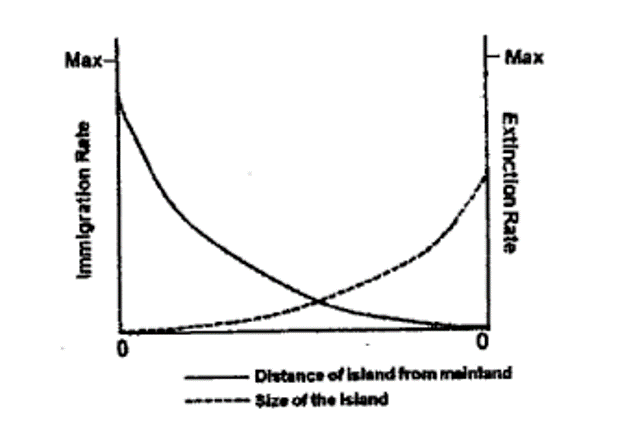
QUESTION ID:16
Inclusive fitness of an animal can be measured as a sum of direct fitness and indirect fitness. Imagine you have 10 off springs. Through diligent parental care, 5 survive to reproduce. You give your life in a heroic deed to save a total of 5 of your nieces and nephews. What is your inclusive fitness?
QUESTION ID:17
Altruism describes a behaviour performed by animals that may be disadvantageous to self while benefitting others. Which one of the following statements is INCORRECT about altruism?
QUESTION ID:18
Given are some statements with reference to the use of genes in plant molecular systematics.
A. mtDNA are not preferred over cpDNA or rDNA because they generally show slow rate of sequence evolution and fast rate of structural evolution.
B. cpDNA are not preferred because of their haploidy, uniparental inheritance, and absence of recombination among cpDNA molecules.
C. rDNA such as ITS are preferred for their higher evolutionary rates as well as shorter sequence length.
D. rDNA and cpDNA cannot be used simultaneously in molecular systematics since they represent conflicting patterns of inheritance.
Which of the above statements are INCORRECT?
QUESTION ID:19
Following are key points about the effect of genetic drift:
A. Genetic drift is significant in small populations.
B. Genetic drift can cause allele frequencies to change in a predirected way.
C. Genetic drift can lead to a loss of genetic variation within populations.
D. Genetic drift can cause harmful alleles to become fixed.
Which one of the following combination of the above statements are true?
QUESTION ID:20
Following table contains some of the generalizations of evolutionary biology: Which of the following is correct match between Column I and II?
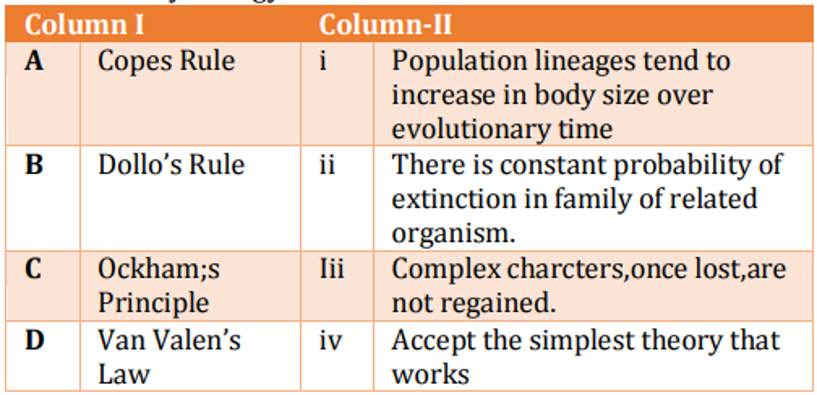
QUESTION ID:21
A 1257 bp genomic DNA sequence of a prokaryotic gene was cloned under a strong constitutive promoter along with a suitable polyA signal and used for development of transgenic tobacco plants. Molecular analysis revealed the presence of three types/lengths of transgene derived mRNAs: 555 bp, 981 bp and 1257 bp - in the leaves of transgenic plants. The following statements were proposed to explain the above results.
A. The three mRNAs represent alternatively spliced transcripts due to the presence of putative intronic sequence in the gene.
B. The gene sequence was characterized by the presence of potential polyadenylation signals that resulted in premature termination of transcription.
C. Expression of full-length transcripts (1257 bases) was lethal to the transformed cells.
D. The transgenic plants were chimeric in nature and comprised of a mix of transformed and untransformed cells.
Which of the following combinations of the above statements would correctly explain the obtained results?
QUESTION ID:22
In order to detect minor variations in antigen concentration, the following procedures were suggested. Which one will likely be the best option?
QUESTION ID:23
Three students (P, Q, R) in a research lab were trying to identify proteins that interact with a transcription factor X. P performed gel filtration experiments and identified that X was found along with proteins A, B, C and D. Q performed coimmunoprecipitation experiments using antibodies to X and identified A, B and C. R did a yeast-2-hybrid screen and identified only B.
The following are likely conclusions that may explain all the results:
(i) A, B, C and D are in a complex with X.
(ii) X directly interacts with B.
(iii) Only A, Band C are in complex with X.
(iv) D is probably weakly associated with X.
Which of the above conclusions best explains all the results?
QUESTION ID:24
Sub-cellular fractionation-based assays have been used to identify various organelles in the mammalian cells. In order to characterize such organelles in a living mammalian cell, which of the following microscopy-based method would be the most accurate?
QUESTION ID:25
From the following statements,
A. Surface plasmon resonance can be used to determine binding constants only in the range of 102 - 103 M.
B. de novo sequencing is not possible by mass spectral methods.
C. The position of hydrogen atoms in proteins is not directly determined by X-ray, diffraction.
D. Circular dichroism and nuclear magnetic resonance spectroscopy do not give the same information on protein structure.
Choose the option with all correct statements.
QUESTION ID:26
A researcher attempted to clone two genes (X and Y) independently in a plasmid vector for over expression and purification in E. coli. All attempts to clone gene X were unsuccessful whereas gene 'Y' could be cloned easily. When the, researcher attempted to clone gene 'X' in the plasmid clone containing gene 'Y', gene 'X' could be cloned. The following statements were proposed to explain the above results.
A. Protein encoded by gene 'Y' is not lethal to the cell.
B. Gene 'X' has introns, which prevents its expression in E. coli
C. Expression of 'X' protein is lethal to the cell.
D. The 'Y' gene product inhibits the activity of 'X' protein
Which one of the following options represents a combination of correct statements to explain the observations?
QUESTION ID:27
In order to visualize the intracellular organization of a cell, one can utilize various microscopy-based techniques. These include:
A. Differential interference contrast (DIC) microscopy
B. Phase contrast microscopy
C. Dark field microscopy
D. Epifluorescence microscopy
E. Scanning electron microscopy
F. Transmission electron microscopy
G. Confocal microscopy
Which of the above mentioned microscopes can be used to study the intracellular dynamics using live cell imaging?
QUESTION ID:28
A certain protein has been assumed to play an indispensable role in the survival of an intracellular parasite inside the host cells. Which one of the following techniques will best prove the assumption to be correct?
QUESTION ID:29
Given below is a table with information on isotopes, their half-life and type of particle(s) they emit. Choose the correct combination from the options given below.

QUESTION ID:30
Which one of the following set of essential components are required for Sanger method of DNA sequencing in a required buffer containing MgCl2 and Tris-HCl?
 TLS Online
TLS Online